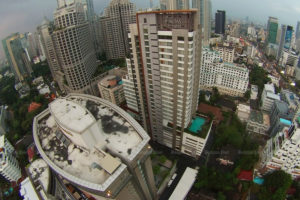
High-rise rule would be wind of change for Bangkok
Proposed new regulation would require a project developer to submit a three-dimensional projection to ensure a project will not block wind and light
Earlier this month, there was good news in terms of public safety and the urban environment. It was reported that the Office of Natural Resources and Environmental Policy and Planning (Onep) was going to enforce a more stringent environmental impact assessment (EIA) rule for high-rise building developers.
Needless to say, the move faced fierce resistance from the Housing Business Association, the Thai Condominium Association and the Thai Real Estate Association. These groups lamented the proposed rule saying it would make it harder for investors to develop projects and make properties more expensive. Needless to say, after the resistance from developers the government then seemed to backpedal.
Essentially, the proposed new regulation would require a project developer to submit a three-dimensional projection to ensure a project will not block wind and light. This was in response to complaints by residents of communities who had been by air ventilation and sunlight being changed by high-rise projects. Given the resistance from developers, it remains uncertain whether Onep will dare to impose the new rule deemed to hurt the business sector which has already suffered under Covid. The future looks bleak for such a good environmental law. During the public hearing last Friday, Onep created confusion by saying it would only be a “guideline”, not a “regulation”.
Witnessing such an amateurish performance from Onep, a crucial state environmental regulatory body, I can only imagine how unlivable the Bangkok metropolitan area will become in the future.
The impact of high-rise buildings on wind and sunlight affects more than housewives hanging out their laundry to dry or residents who want to go outdoors and enjoy the natural breeze. Poor ventilation on a large scale means the air becomes stagnant which eventually leads to air pollution. Indeed, the PM2.5 pollution problem in Bangkok is reported to be partly the result of a lack of wind and ventilation to disperse dust particles in the upper atmosphere.
The lukewarm approach by the Thai government agency is in stark contrast to Japan. I remember watching an episode of the Bosai programme called “Urban windstorm” on the NHK World channel early this year.
The episode studied Typhoon Jebi that lashed Osaka in 2018, blowing over dozens of lorries and cars and causing a camera store building in Namba to collapse. Experts in the programme studied why Namba Station, one of two major centres in Osaka, suffered more severe damage than the other.
A simulation was made to show how wind flow was amplified after being blocked by buildings. Another simulation showed how the pattern of buildings’ locations can change the wind pattern — making the wind stronger or weaker. On the show, Assoc Prof Tetsuya Takemi, an expert at the Disaster Prevention Research Institute, Kyoto University, found that strong winds are likely to occur in communities with a mix of densely packed buildings of various heights — from low-rise to skyscrapers. In the case of Typhoon Jebi, wind intensity and speed was enhanced as it circulated within the concrete jungle, eventually hitting and leading to the collapse of the camera store building near Namba Station.
After watching the programme, I could not help recalling an image of a 9,000-unit condo in Bangkok which was shared extensively on social media last year. In the picture, a row of four gigantic condo buildings — about 400 metres long on the site of a former textile factory — located in the Bang Son area near the Purple Line, was featured. Having a cityscape can be considered a big development for Bangkok, but it also shows how ignorant officials can be for not taking into account the effects of urban ventilation and flooding.
Reading the comments, one could easily imagine how this enormous project — one of dozens in Bangkok — could be detrimental to neighbouring residents. A netizen who said she lived close to one of the buildings said her house, which had once enjoyed plenty of sunlight and ventilation, was now under the shadow of the high-rise condominium.
Another woman who lived in a house next to the project said the wind had become much stronger and that she was afraid the roof of her house would be blown away.
A netizen who said he’d been living in the neighbourhood for over 30 years, had experienced changes to the wind flow with the air quality getting worse after many condominium projects sprouted up in the community.
I’m sure that the colossal project in the Bang Son area isn’t the first and won’t be the last. Bangkok is likely to face more man-made disasters that look as if they are caused by nature. And it will be a shame if Onep squanders the chance to make high-rises safer and more environmentally friendly by backpedalling on this worthy EIA regulation.
SIRINYA WATTANASUKCHAI
COLUMNIST
Sirinya Wattanasukchai is a columnist for the Bangkok Post.
Source: https://www.bangkokpost.com/opinion/opinion/2138783/high-rise-rule-would-be-wind-of-change-for-city


